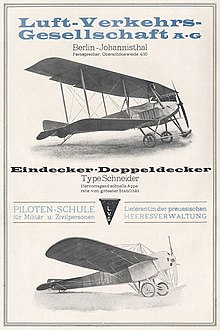Air transport company (LVG)
| Luft-Verkehrs-Gesellschaft AG (LVG) Luft-Verkehrs-Gesellschaft mbH. |
|
|---|---|
| legal form | |
| founding | 1910 (as Luftfahrtbetriebs-GmbH ) |
| Seat | Berlin , Johannisthal Airfield , Germany |
| management | Franz Schneider (chief designer) |
| Number of employees |
|
| Branch | Aircraft manufacturer |
The Luft-Verkehrs-Gesellschaft AG (LVG for short) at the Johannisthal airfield emerged in 1912 from the Luft-Verkehrs-Gesellschaft mbH by Arthur Müller , which was founded in 1910 under the name Luftfahrtbetriebs-GmbH as a company for passenger and advertising trips with Parseval airships was founded.
history
After the idea of the airship advertising trips had indeed accepted the predecessor company well by the market, but the orders are not due to technical problems largely departed were, the air-transport company focused AG on the aircraft. For this purpose, Franz Schneider was brought into the company as chief designer in 1911 . From 1912 he introduced the LVG B and C types , which were also advertised as Schneider types . In 1913 he developed a machine gun synchronization between the engine and machine gun, which revolutionized aerial combat in World War I from 1915 , and built it into the LVG EI , which, however, was not used.
Further designers at the LVG were the engineers Walter Rethel , Willy Sabersky-Müssigbrodt, Felix Laitsch and Paul Georg Ehrhardt , from 1917 head of the test department.
Until 1918, the LVG mainly built two-seat training and reconnaissance aircraft, including the LVG CI , the first German two-seater at the front, in which the observer had a swiveling machine gun on a rotating ring mount with a clear field of fire. and produced with more than 1,000 and very successfully used LVG C.VI .
LVG produced 5,640 aircraft in the First World War and was the second largest aircraft manufacturer in the German Empire after the Albatros . In the whole of 1913, with 300 workers, the number of aircraft delivered was 60, but production capacity rose steadily through expansions. In May 1918 alone 174 machines left the factory and the company now employed 3,500 workers.
List of aircraft types
- LVG BI - reconnaissance aircraft, later training aircraft
- LVG B.II - reconnaissance aircraft, later training aircraft
- LVG B.III - trainer aircraft
- LVG CI - first standard two-seater with movable. Observer MG
- LVG C.II - reconnaissance
- LVG C.III (?)
- LVG C.IV - reconnaissance
- LVG CV - reconnaissance
- LVG C.VI - over 1,000 machines delivered
- LVG C.VIII - prototype only
- LVG C.IX - not completed
- LVG C.VIII - prototype only
- LVG D 10
- LVG D.II - only prototype
- LVG D.III - only prototype
- LVG D.IV - prototype only
- LVG DV - prototype only
- LVG D.VI - prototype only
- LVG EI - test aircraft with 2 MG
- LVG GI - Bomber
- LVG G.II - three-decker
- LVG G.III - three-decker (also manufactured under license as Schütte-Lanz GV )
literature
- Peter M. Grosz: LVG C.VI. (Windsock data file No. 17). Albatros Prod., Berkhamsted 1989, ISBN 0-948414-21-9 .
- Rainer Karlsch / Thomas Flemming / Burghard Ciesla : 100 years of innovation from Adlerhof - the cradle of German motorized aviation . In: WISTA-MANAGEMENT GMBH (Ed.): Adlerhof stories . tape 1 . Berlin June 2009, p. 72 ( Leseprobe.pdf [accessed on January 28, 2017]).
- Karlheinz Kens, Hans Müller: The aircraft of the First World War . Munich 1966, ISBN 3-453-00404-3 .
- Günter Kroschel, Helmut Stützer: The German military aircraft 1910–1918 . Wilhelmshaven 1977, ISBN 3-920602-18-8 .
- Heinz J. Nowarra: Airplanes 1914–1918 . Munich 1959, DNB 453613632 .
- Karl R. Pawlas: German Aircraft 1914-1918 . Nuremberg 1976, ISBN 3-88088-209-6 .
- Günter Schmitt: When the classic cars flew. transpress Verlag für Verkehrwesen 1987, ISBN 3-344-00129-9
- Henry Wydler: Schneider, Franz. In: Historisches Lexikon der Schweiz .
Web links
Individual evidence
- ↑ a b cradle of German motorized aviation p. 8
- ↑ a b When the classic cars flew p. 80
- ^ Henry Wydler: Schneider, Franz. In: Historisches Lexikon der Schweiz .
- ↑ Kenneth Munson: Fighter Planes 1914-19 . Zurich 1968., cf. also description under Lemma Fokker monoplane
- ↑ Yuri Balashov, Vladimir Pavlovich Vizgin: Einstein Studies in Russia. Boston 2002, ISBN 0-8176-4263-3 , p. 298.
- ^ Enzo Angelucci, Paolo Matricardi: Airplanes from the beginning to the First World War . Wiesbaden 1976, ISBN 3-8068-0391-9 .

